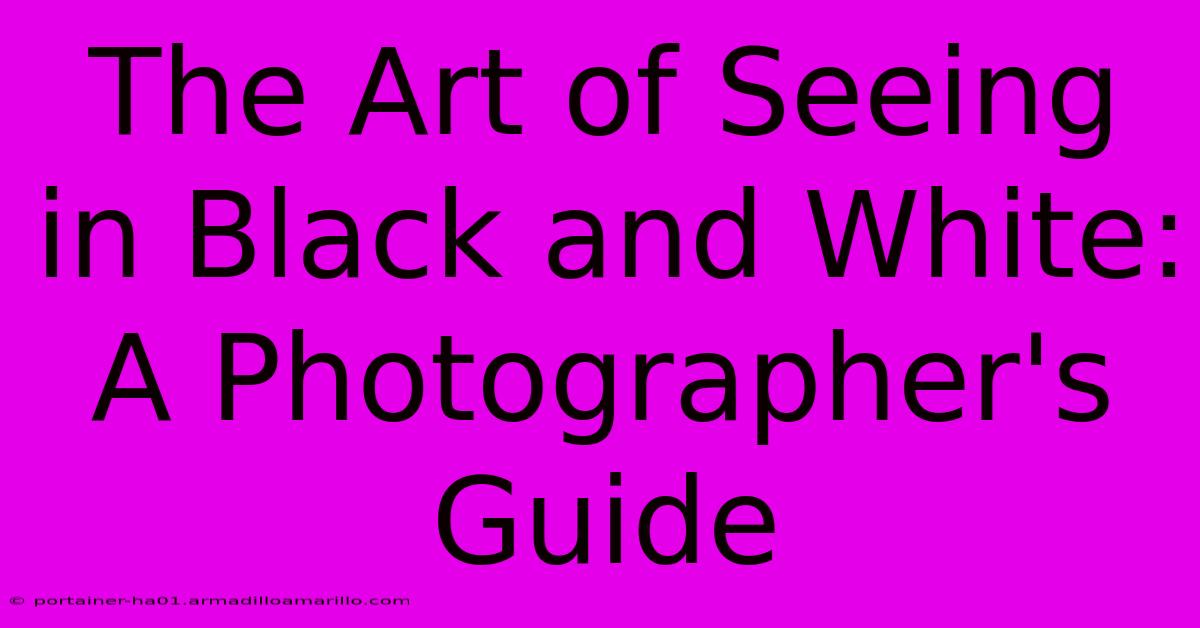The Art Of Seeing In Black And White: A Photographer's Guide

Table of Contents
The Art of Seeing in Black and White: A Photographer's Guide
The allure of black and white photography lies in its ability to transcend the limitations of color, stripping away the distractions and revealing the essence of a scene. It's not just about removing color; it's about seeing in monochrome, a skill that requires practice, understanding, and a keen eye for composition, light, and shadow. This guide will explore the art of capturing compelling black and white images.
Understanding the Power of Monochrome
Black and white photography forces you to focus on the fundamental elements of photography: light, shadow, texture, form, and tone. Color, often a dominant feature, is removed, emphasizing these core elements in a way that color images often can't. This simplification can lead to images with incredible depth and impact.
The Importance of Light and Shadow
Light and shadow are the architects of a successful black and white photograph. Contrast becomes your primary tool. High contrast images, with stark blacks and bright whites, create dramatic and powerful statements. Low contrast images, with subtle gradations of grey, offer a more subdued and nuanced feel. Learn to anticipate how light will interact with your subject, understanding how it sculpts form and reveals texture.
Texture and Form: Unveiling the Details
Black and white photography excels at highlighting texture. The rough bark of a tree, the wrinkles on a face, the grain of wood – these details become pronounced when color is removed. Similarly, form takes center stage. The three-dimensionality of your subject is enhanced by the interplay of light and shadow, creating a powerful sense of depth and volume.
Mastering the Technical Aspects
While artistic vision is crucial, understanding the technical aspects will significantly enhance your black and white images.
Choosing the Right Equipment
While any camera can shoot in black and white, some offer features that are particularly helpful. Cameras with manual controls give you complete freedom over exposure and other settings, allowing for greater creative control.
Shooting in RAW: Preserve the Details
Shooting in RAW format provides maximum flexibility in post-processing. RAW files retain significantly more information than JPEGs, giving you more latitude to adjust tones and contrast during editing.
Post-Processing Techniques: Enhancing Your Vision
Post-processing is an integral part of black and white photography. Software like Adobe Lightroom or Photoshop allows you to fine-tune your images, adjusting contrast, brightness, shadows, highlights, and clarity. Experiment with different techniques to achieve your desired aesthetic. Consider using split toning to add warmth or coolness to your shadows and highlights.
Finding Inspiration and Developing Your Style
Mastering black and white photography is a journey, not a destination. Continuously explore, experiment, and learn from others.
Studying the Masters
Study the work of renowned black and white photographers like Ansel Adams, Dorothea Lange, and Henri Cartier-Bresson. Analyze their compositions, lighting choices, and the overall mood they create. Understanding their techniques will help you develop your own style.
Exploring Different Genres
Experiment with various genres of photography, from landscapes and portraits to street photography and abstract imagery. Each genre presents unique challenges and opportunities for creative expression in black and white.
Practicing Regularly
The key to improvement is consistent practice. Shoot regularly, experiment with different settings and techniques, and critically analyze your results. The more you practice, the better you will become at seeing the world in black and white.
Conclusion: Embracing the Monochrome Aesthetic
Black and white photography is a rewarding and challenging art form. By understanding the technical aspects, honing your artistic vision, and embracing the power of light and shadow, you can create truly stunning and timeless images. Remember, it's not just about removing color; it's about seeing the world in a new and exciting way. So grab your camera, embrace the monochrome aesthetic, and start creating your own masterpieces.

Thank you for visiting our website wich cover about The Art Of Seeing In Black And White: A Photographer's Guide. We hope the information provided has been useful to you. Feel free to contact us if you have any questions or need further assistance. See you next time and dont miss to bookmark.
Featured Posts
-
Breaking The Vicious Cycle Overcoming The Escalation Of Commitment Confirmation Bias
Feb 06, 2025
-
Huephoria The Ultimate Guide To Spray Rose Colors And Meanings
Feb 06, 2025
-
The Heal Heel Headache How To Avoid A Painful Mismatch
Feb 06, 2025
-
Escape To Tranquility Tommy Bahamas Logo As Your Coastal Getaway
Feb 06, 2025
-
Unveiling The Pristine Beauty Of The Singke White Gerbera
Feb 06, 2025
